I'm fairly certain that the problems with ragged responses that you see in simulations in axidriver are due to the fact that they are for axisymmetric geometries. I.e. this is a simulation of a cylinder with the waveguide on one end:

Circular baffles with driver at center gives very bad problems with diffraction.
If the baffle was instead rectangular and driver preferably not at the center you would get a much smoother response, but this requires 3D-models.
I do however agree with the threads idea, you need to consider the whole enclosure when designing the polar response of a speaker. Just designing a waveguide with the assumption of infinite baffle and then putting the waveguide in an enclosure will result in sub-par performance.
/Anton

Circular baffles with driver at center gives very bad problems with diffraction.
If the baffle was instead rectangular and driver preferably not at the center you would get a much smoother response, but this requires 3D-models.
I do however agree with the threads idea, you need to consider the whole enclosure when designing the polar response of a speaker. Just designing a waveguide with the assumption of infinite baffle and then putting the waveguide in an enclosure will result in sub-par performance.
/Anton
Here's an ABEC example that shows the change in directivity lower in frequency from a complete enclosure vs the same waveguide in an infinite baffle. The same sort of sim could be run for a Revel size bookshelf speaker. Considering the entire enclosure is important (particularly if you are targeting a specific directivity) as it can have quite a large influence on the final result.
This is done with 1/4 symmetry to save solving time but due to the size of the enclosure (574mm wide) and the resolution of the mesh it still takes 3 hours to solve.
This is done with 1/4 symmetry to save solving time but due to the size of the enclosure (574mm wide) and the resolution of the mesh it still takes 3 hours to solve.
Attachments
-
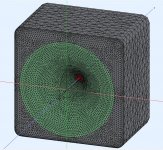 36mm Roundover ABEC.jpg392.8 KB · Views: 589
36mm Roundover ABEC.jpg392.8 KB · Views: 589 -
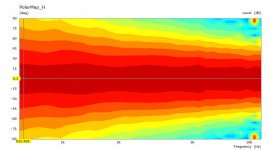 36mm Rounded H Polar.jpg33.3 KB · Views: 613
36mm Rounded H Polar.jpg33.3 KB · Views: 613 -
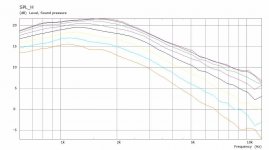 36mm Rounded H SPL.jpg48.2 KB · Views: 593
36mm Rounded H SPL.jpg48.2 KB · Views: 593 -
 HF1440 IB H Polar.jpg30.8 KB · Views: 582
HF1440 IB H Polar.jpg30.8 KB · Views: 582 -
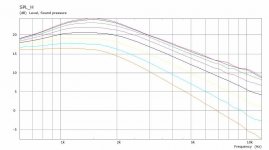 HF1440 IB H SPL.jpg48.5 KB · Views: 262
HF1440 IB H SPL.jpg48.5 KB · Views: 262 -
 Freespace Baffle Rad Imp.jpg43.7 KB · Views: 224
Freespace Baffle Rad Imp.jpg43.7 KB · Views: 224 -
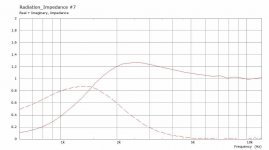 IB Rad Imp.jpg43.7 KB · Views: 215
IB Rad Imp.jpg43.7 KB · Views: 215
I wonder if the Yamaha DXR12 mk2 are as good or better as the original. The price is right on them and I have some spare cash🙂
Based on the difference in the spec sheet, I have a hunch they replaced the $45 ferrite tweeter with this:
Celestion CDX1-1730 1" 40 Watt Neodymium Compression Driver 8 Ohm
The use of neodymium raises efficiency a couple dB, which in turn raises maximum ouput by a couple dB.
Getting a $140 compression driver in an $800 speaker is pretty cool 🙂
Celestion CDX1-1730 1" 40 Watt Neodymium Compression Driver 8 Ohm
The use of neodymium raises efficiency a couple dB, which in turn raises maximum ouput by a couple dB.
Getting a $140 compression driver in an $800 speaker is pretty cool 🙂
Here's an ABEC example that shows the change in directivity lower in frequency from a complete enclosure vs the same waveguide in an infinite baffle. The same sort of sim could be run for a Revel size bookshelf speaker. Considering the entire enclosure is important (particularly if you are targeting a specific directivity) as it can have quite a large influence on the final result.
This is done with 1/4 symmetry to save solving time but due to the size of the enclosure (574mm wide) and the resolution of the mesh it still takes 3 hours to solve.
Is the first set of curves for the infinite baffle and the second for the complete enclosure?
What computer were you using which took three hours to complete the sim? I might be getting a new system so it'd be useful to know how much grunt is needed for simulations.
The left set of curves is in the enclosure, the right set is the Infinite Baffle. So the smoother curves are those of the infinite baffle and the ones that extend the directivity lower and smoother belong to the enclosure.
A core i7 8750H laptop with 16 GB of RAM. ABEC bogs down on high element count simulations like this one, so unless you are going to use a threadripper then it will still take a while. If you keep the element count to something like 2000 (instead of the 5000 here) then the time is more like 30 to 45 minutes depending on how many degrees of freedom the design has.
A core i7 8750H laptop with 16 GB of RAM. ABEC bogs down on high element count simulations like this one, so unless you are going to use a threadripper then it will still take a while. If you keep the element count to something like 2000 (instead of the 5000 here) then the time is more like 30 to 45 minutes depending on how many degrees of freedom the design has.
Read this on another forum. You can google it if you want the full quote. The other part of the discussion regarded resonances in speakers. He explained where resonances came from but said you don't hear them unless they show up in the frequency response measurements.
"Box shape is a factor, but a small one. Internal resonances are easily damped with fluff. Curved surfaces can be beneficial, or not, depending on how they fit into the total structure. Mostly it is a visual aesthetic issue, part of the industrial design, and having something to say in the literature, whether it affects the sound or not." - Floyd Toole
Thanks for the info. The cabinet having better control over dispersion is a bit unexpected.
I'm kinda surprised they haven't coded to CUDA, because this is the sort of embarrassingly parallel problem GPUs eat for breakfast. Maybe AKABAK is GPU-enabled?
I'm kinda surprised they haven't coded to CUDA, because this is the sort of embarrassingly parallel problem GPUs eat for breakfast. Maybe AKABAK is GPU-enabled?
In that instance Floyd Toole is speaking more about cabinet shape from the inside, that a driver sees a volume more than the shape. Many decisions are made for industrial design reasons but the outside shape of an enclosure has a big impact on diffraction and to a lesser extent directivity. The sculpted front baffle of the Salon 2 is not just for show.Read this on another forum.
Why unexpected?Thanks for the info. The cabinet having better control over dispersion is a bit unexpected.
It's not "they" ABEC/AKABAK is all done by Joerg Panzer alone, it is an amazing achievement for a single person. There is no GPU offload ability. The more CPU cores you have and the more RAM you have to feed them the quicker it goes but there is a bottleneck when the element count increases where the solution to the problem becomes exponentially more difficult to solve taking much more time.I'm kinda surprised they haven't coded to CUDA, because this is the sort of embarrassingly parallel problem GPUs eat for breakfast. Maybe AKABAK is GPU-enabled?
The CPU time is just one part of the process, generating CAD files and meshes and inputting the data in a project usually takes longer than the solve time. Using simplifications like the infinite baffle and adjusting the mesh resolution to keep the element count under control and Ath to generate the waveguide surface makes the development stage much faster.
What I have shown is the end of the line freespace high element count last check to see if everything works the way it should, you won't do this that often in comparison to the much quicker initial simulations.
Using CirSym to solve the profile shape of an axisymmetric guide can be done in seconds on any device, it's only when you make the question harder that the solution takes longer 🙂
Toole, again
Something else Toole said was that once you're within a window of frequency response deviation from dead flat the speaker doesn't get any better to the ear. So maybe diffraction causes a blip, but an inaudible blip. And probably less audible or consequential if it doesn't cause a difference in the direct vs indirect sound. Is there evidence that diffraction alters the direct vs indirect sound and that it is large enough to recognize?
My suspicion is that the baffle shaping on the Salon 2 are to make them look more attractive and create visual product differentiation.
"Listening outdoors - i.e. almost anechoic, just a "floor bounce" - or in an anechoic chamber is a dreadful experience. You only hear the direct sound, which is a tiny part of what you hear in a room. What distinguishes good loudspeakers is how the indirect sounds compare to the direct sound. Also, the bass is greatly attenuated. Stick to a room, even with its warts." - Toole
Something else Toole said was that once you're within a window of frequency response deviation from dead flat the speaker doesn't get any better to the ear. So maybe diffraction causes a blip, but an inaudible blip. And probably less audible or consequential if it doesn't cause a difference in the direct vs indirect sound. Is there evidence that diffraction alters the direct vs indirect sound and that it is large enough to recognize?
My suspicion is that the baffle shaping on the Salon 2 are to make them look more attractive and create visual product differentiation.
Diffraction tends to occur in 'other' places, so yes this suggests spatial variations.
Geddes says that diffractions don't need to cause significant looking changes to response, to be audible.
Is your Toole quote in context there, it seems a little out of place?
Geddes says that diffractions don't need to cause significant looking changes to response, to be audible.
Is your Toole quote in context there, it seems a little out of place?
Is there evidence that diffraction alters the direct vs indirect sound and that it is large enough to recognize?
A good example of measured differences
Basic article | Baffle geometry
That no doubt plays a part, doesn't stop it from measuring better than a flat baffle though.My suspicion is that the baffle shaping on the Salon 2 are to make them look more attractive and create visual product differentiation.
Diffraction can also make you find the speakers more easily within the sound field. The more diffraction is avoided, the better the speakers disappear as the source of the music. Making imaging a lot more fun. All in all enough reasons to think about.
Slightly off topic but...
In a previous career I managed a very large structural analysis software package. We found that the speed of computation could be limited by several different bottlenecks... processor speed, RAM, disk I/O, network speed and latency.
In your case, I suspect that 16 GB of RAM is not enough to keep CPU happy. I bet the CPU is using disk space as an overflow. With a mechanical hard drive this can get super slow, but even with a solid state hard drive it is much slower than RAM. For our application, we found we needed at least 64 GB of RAM to max out the capability of an i7 processor. Otherwise the CPU spent a lot of time waiting for reads/writes to the disk.
A core i7 8750H laptop with 16 GB of RAM. ABEC bogs down on high element count simulations like this one, so unless you are going to use a threadripper then it will still take a while. If you keep the element count to something like 2000 (instead of the 5000 here) then the time is more like 30 to 45 minutes depending on how many degrees of freedom the design has
In a previous career I managed a very large structural analysis software package. We found that the speed of computation could be limited by several different bottlenecks... processor speed, RAM, disk I/O, network speed and latency.
In your case, I suspect that 16 GB of RAM is not enough to keep CPU happy. I bet the CPU is using disk space as an overflow. With a mechanical hard drive this can get super slow, but even with a solid state hard drive it is much slower than RAM. For our application, we found we needed at least 64 GB of RAM to max out the capability of an i7 processor. Otherwise the CPU spent a lot of time waiting for reads/writes to the disk.
I have done some experiments with taping sharp cardboard edges around my well rounded cabinets, and then measured and listened to the effects.
If the hard edges result in measurable peaks and dips that are large, +/- 3 dB, it is easy to detect. I had to make the edges pretty stupid to get an effect this big.
If the hard edges resulted in measurable peaks and dips which were small, +/- 1.5 dB, it was very hard to hear the effect on most program material. Pop, rock, electronic music, movie soundtracks... this small diffraction effect was of little consequence.
However, with naturally mic'd live performances, I could hear the difference, and it was not subtle. The three dimensional aspects of the sound field were damaged by even a small amount of diffraction.
So my conclusion, for my system and my ears, is that cabinet edge diffraction has an effect that goes beyond its impact on frequency response. It affects the 3 dimensional quality of the music, but only with music that has preserved that aspect through the recording/reproduction process.
If the hard edges result in measurable peaks and dips that are large, +/- 3 dB, it is easy to detect. I had to make the edges pretty stupid to get an effect this big.
If the hard edges resulted in measurable peaks and dips which were small, +/- 1.5 dB, it was very hard to hear the effect on most program material. Pop, rock, electronic music, movie soundtracks... this small diffraction effect was of little consequence.
However, with naturally mic'd live performances, I could hear the difference, and it was not subtle. The three dimensional aspects of the sound field were damaged by even a small amount of diffraction.
So my conclusion, for my system and my ears, is that cabinet edge diffraction has an effect that goes beyond its impact on frequency response. It affects the 3 dimensional quality of the music, but only with music that has preserved that aspect through the recording/reproduction process.
A good example of measured differences
Basic article | Baffle geometry
That no doubt plays a part, doesn't stop it from measuring better than a flat baffle though.
If it looks better and measures better I think you should do it even if you can't hear it.
Also, maybe you can hear it. What I like about Toole is that he identifies the windows of human perception. Within that window, a better measurement doesn't matter. You want to get in that window but once you're in, you're in. He said once you get to a certain point there's no difference in statistical preference between speakers. If you control for the low frequency deviations you get effectively zero statistical difference.
The Revel Salon 2s have an increasing directivity index. I'd think that has a far more consequential impact on perceived sound quality preference of that speaker than the shaped baffles.
At present, and my opinion can change, my feeling is that visual appeal should be emphasized over edge diffraction measurements. If I want to DIY a speaker to sound like the Salon 2 I'm not going to worry about the baffle shaping. I'm going to try to match the frequency response and directivity index. After that, I think you get more benefit from making them look pretty than anything else.
To be clear, I'm not saying everyone should build speakers to match the Salon 2 directivity index. I'm just saying if you want your speaker to sound like that specific speaker, that's your target. If you want your speaker to sound like a different speaker you target that other speaker's frequency response and directivity index.
- Home
- Loudspeakers
- Multi-Way
- Loudspeaker Enclosures are Waveguides